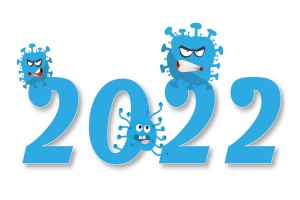
COVID-19 Notes
 By Dr. Satish K Gupta*
By Dr. Satish K Gupta*
Viruses with an animal vector like Corona always have the possibility of re-emerging as a novel human pathogen
Effective vaccine and or effective anti viral drug remain the keys to ending any pandemic. HIV was defeated using an effective antiviral while small pox was eradicated using a vaccine. Flu pandemic ended even without either of the two. How will COVID-19 end? Will rich and mighty win this earlier? How will we come to know that virus is no more a threat?
Looking back at some of our previous pandemics or epidemics can give us an insight into some if these questions, both in epidemiological and social terms.
1918 FLU PANDEMIC
Similar to COVID-19, the disease came in waves, making people feel as though they had defeated the virus, only to be struck with another round of illness. Around four waves occurred between 1918 and 1920, with the second wave of 1918 causing the majority of deaths.
With no vaccine or treatments on the way, people attempted public health measures that are familiar to all: masking, discouraging public gatherings.
So how did it end?
The hypothesis is generally that the flu either could have become milder or ultimately affected enough people so that it no longer had populations to affect at such a scale that it could remain a pandemic.
Essentially, the virus either evolved to be milder or simply burned through the population.
Ultimately the virus ran out of people and that meant there was a massive death toll before the virus dissipated. Flu affected more than 500 million people, and around 50 million people died worldwide. (Current official toll of COVID-19 is more than 5.6 million).
1918 flu may have ended through the virus becoming milder or herd immunity being achieved because so many people had been exposed; this is far from a guaranteed conclusion for COVID-19. Especially as we see continuing emergence of variants and the possibility of infection evading the immunity conferred by vaccination.
One could say pandemic ended not just when the third or fourth wave ended, but also there was a really active effort by the public and by politicians to forget it. There are countless memorials to those who died in the various wars, there are no memorials to the millions of people who died during the pandemic, and it is not a coincidence.
SMALL POX
Small pox holds the unique distinction of being the only infectious disease that we have wholly eradicated through vaccination — a feat that was achieved nearly 200 years after a vaccine was invented.
So can we vaccinate COVID-19 out of existence by effective vaccination?
We could eradicate small pox because it was a human-only virus, meaning that it could only spread between humans and didn’t have an animal vector, the way that many influenza viruses do. However, COVID-19 is thought to have originated in an animal before it made the jump to humans, and viruses with an animal vector always have the possibility of re-emerging as a novel human pathogen. And the sudden appearance of Omicron is making us rethink these lines.
Those with small pox also had distinct dermatological symptoms to identify them, which is not the case with most respiratory diseases.
We’ve never eradicated a respiratory disease!
Diseases don’t end because you have announced that you have an effective vaccine, which is something that we have learned the hard way through COVID-19.
HIV
According to the World Health Organization (WHO), around 36.3 million people have died of HIV.
The world could not end HIV; we just defeated it with effective drugs made available to the masses. The HIV epidemic taught the world that viruses don’t respect the man-made boundaries of land or money. Virus anywhere in the world is a threat to the whole of mankind.
Widespread access to reliable treatments allow a person with HIV to live a whole life without fear of dying of AIDS or spreading the virus. These antiretroviral drugs work by stopping the virus from replicating inside the body. On similar lines, Pfizer’s new antiviral pill for treating COVID-19 is actually a protease inhibitor, a type of antiretroviral drug that was first developed to treat HIV.
Will the rich and mighty end pandemic earlier?
Priority vaccination has already taught the world that one may not consider a pandemic to have “ended” when the threat has diminished within wealthier nations.
We’ve seen rise in COVID-19 cases, especially in the last few months, once vaccine access had largely been primarily achieved in wealthier nations. We now recognise that without adequate vaccination around the world, we’re going to see, potentially severe variants of concern popping up in places that lack adequate vaccination coverage.
If COVID is raging in different parts of the world, it’s hard to really insulate oneself effectively. Just what’s happening with the Omicron is a classic example.
So Finally, how would COVID-19 go?
There’s never a straightforward answer when we try to apply history’s pandemic lessons to a current or future viruses. There’s rarely a peace agreement with a virus, like an end of a war.
The pandemic end game is not just a matter of epidemiology or vaccine technology or science. It’s as much about politics and human behavior.
One of the most likely scenarios would be closer to the 1918 pandemic, with COVID-19 eventually becoming seasonal and milder. Much more like the flu, it’s going to be endemic, and then there’ll be particular seasons of the year where it’s more likely to be a potential outbreak.
Pandemic seems to be driven by governments. People just want freedom. Once the mortality becomes less than 0.1%, pandemic can be taken to have ended. However, no government is going to announce or televise that pandemic has ended. Slow withdrawal of restrictions allowing life to be normal would be the only way to come to terms with the virus.
Also read: Omicron figures sketchy as just 1% sample is processed for Genome testing
*Dr. Satish K Gupta is an MD in Medicines, a Visiting Senior Consultant Physician and Internist at Max Super Speciality Hospital, and a Clinical Assistant Professor at GS Medical College, Chaudhary Charan Singh University, Meerut. He is the author of Journey of COVID in India: A Doctor’s Perspective.





